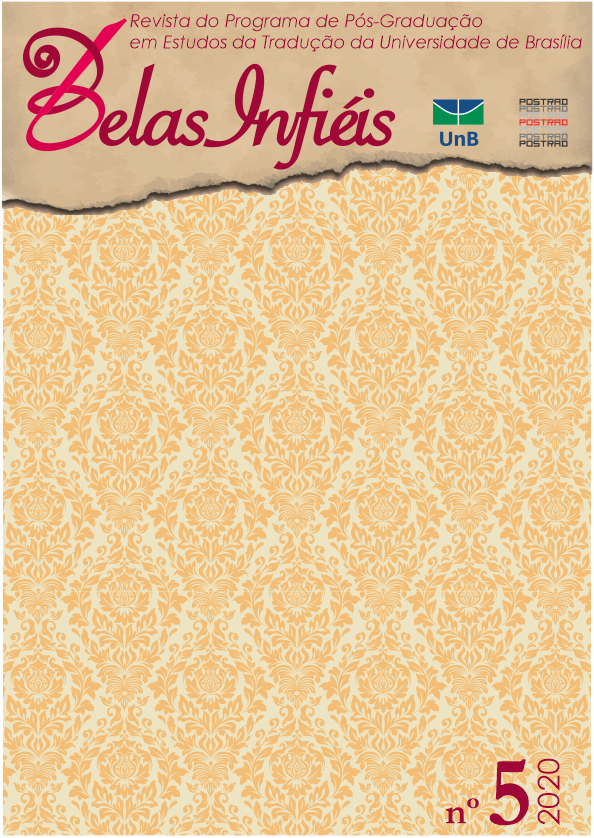Critical Review of Translating Picturebooks: Revoicing the Verbal, the Visual, and the Aural for a Child Audience
DOI:
https://doi.org/10.26512/belasinfieis.v9.n5.2020.31975Keywords:
Translation. Picturebooks. Children’s literature. Multimodality.Abstract
This critical review comments on the work Translating Picturebooks: Revoicing the Verbal, the Visual, and the Aural for a Child Audience, by Riitta Oittinen, Anne Ketola, and Melissa Garavini. The book deals with the translation of picturebooks for a child audience, focusing on the specificities of illustrated works as multimodal entities. The implications of the illustrations in the translator’s practice and the reception of the translations by a public that includes adults and children are discussed in the book. These reflections are inserted within the framework of translation studies concerning multimodality and children’s literature.
Downloads
References
BELL, Allan. Language Style as Audience Design. Language in Society 13, p. 145-204, 1984.
BELL, Allan. Back in Style: Reworking Audience Design. In: ECKERT, P. e RICKFORD, J. (org.). Style and Sociolinguistic Variation. New York: Cambridge University Press, 2001, p. 139-169.
BERGER, Arthur Asa. Seeing Is Believing: An Introduction to Visual Communication. London and Toronto: Mayfield Publishing Company, 1998.
BOSCH ANDREU, Emma. Hacia una definición de álbum. Anuario de investigación en literatura infantil y juvenil 5, p. 25-46, 2007.
FRANCO AIXELÁ, Javier. Culture-specific Items in Translation. In: ÁLVAREZ, R. e ÁFRICA VIDAL, M. C. (org.). Translation, Power, Subversion. Clevedon: Multilingual Matters, 1996. p. 52-78.
GILE, Daniel. Integrated Problem and Decision Reporting as a Translator Training Tool. Journal of Specialised Translation 2, p. 2-20, 2004. Disponível em: www.jostrans.org/issue02/art_gile.pdf Acesso em: 09 jun. 2020.
GOLDEN, Seán. Whose Morsel of Lips Will You Bite? Some Reflections on the Role of Prosody and Genre as Non-verbal Elements in the Translation of Poetry. In: POYATOS, F. (org.). Nonverbal Communication and Translation: New Perspectives and Challenges in Literature, Interpretation and the Media. Amsterdam and Philadelphia: John Benjamins Publishing Company, 1997. p. 217-247.
JAKOBSON, Roman. On Linguistic Aspects of Translation. In: BROWER, R. A. (org.). On Translation. New York: Oxford University Press, 1966. p. 232-239.
KRESS, Günther; VAN LEEUWEN, Theo. Reading Images: The Grammar of Visual Design. London and New York: Routledge, 1996.
LEFEVERE, André. Mother Courage’s Cucumbers: Text, System and Refraction in a Theory of Literature. In: VENUTI, L. (org.). The Translation Studies Reader, 3rd ed. London: Routledge, 2012. p. 203-219.
LEWIS, David. Reading Contemporary Picturebooks: Picturing Text. London: Routledge, 2001.
OITTINEN, Riitta. Translating for Children. New York: Garland Publishing, 2000.
O’SULLIVAN, Emer. Comparative Children’s Literature. Translated by Anthea Bell. London and NY: Routledge, 2005. Based on: Kinderliterarische Komparatistik.
PEIRCE, Charles S. Collected Papers by Charles Sanders Peirce. Cambridge: Harvard University Press, 1932.
ROSENBLATT, Louise M. The Reader, the Text, the Poem: The Transactional Theory of the Literary Work. Carbondale and Edwardsville: Southern Illinois University Press, 1978.
SHAVIT, Zohar. Poetics of Children’s Literature. Athens and London: University of Georgia Press, 1986.
TOURY, Gideon. In Search of a Theory of Translation. Tel Aviv: The Porter Institute for Poetics and Semiotics, 1980.
VENUTI, Lawrence. The Translator’s Invisibility: A History of Translation. London: Routledge, 1995.
Downloads
Published
How to Cite
Issue
Section
License
Copyright (c) 2020 CC BY

This work is licensed under a Creative Commons Attribution 4.0 International License.
Given the public access to this journal, the texts are free to use but requires the recognition of the original authorship and initial publication in this journal to be properly stated.
 The journal allows the use of works published for non-commercial purposes, including the right to submit the work to publicly accessible databases. Published contributions are the sole and exclusive responsibility of the author(s).Â



















